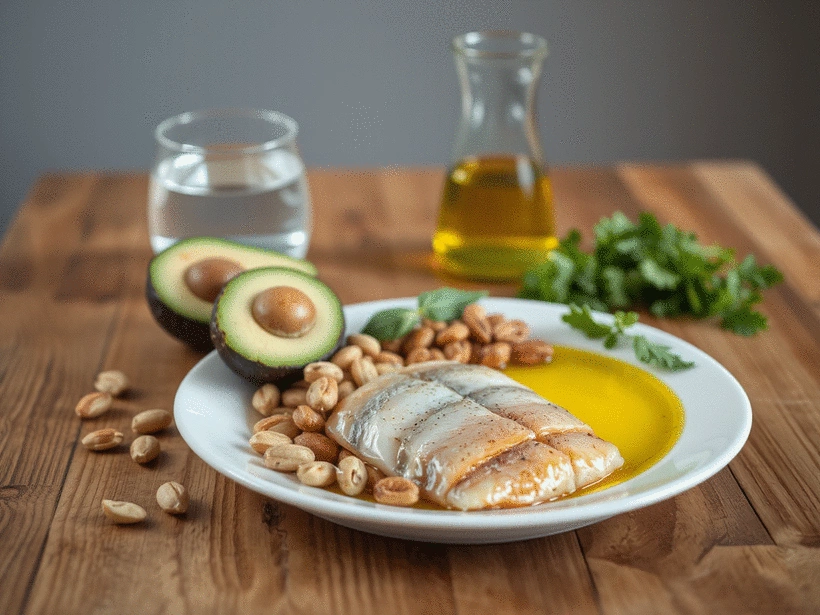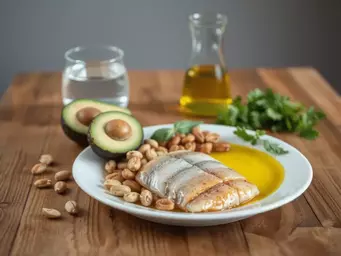High-Fat Foods and Acid Reflux

Have you ever felt that burning sensation in your chest after a meal? You're not alone—acid reflux affects millions. Understanding the connection between your diet and this discomfort can empower you to take control of your digestive health.
What You Will Learn
- Acid reflux occurs when stomach acid flows back into the esophagus, causing discomfort and damage.
- High-fat foods can relax the lower esophageal sphincter (LES), exacerbating reflux symptoms.
- Common dietary triggers include fried foods, full-fat dairy, and processed snacks.
- Being aware of your symptoms, like heartburn and regurgitation, can help you manage your dietary choices effectively.
- Limiting high-fat meals can reduce the time food stays in the stomach, thereby minimizing acid exposure.
- Monitoring both fat content and overall caloric intake is essential for managing symptoms of acid reflux.
The Impact of High-Fat Foods on Acid Reflux
High-fat foods can significantly impact acid reflux symptoms by relaxing the Lower Esophageal Sphincter (LES) and increasing stomach acid exposure. Below is a visual summary of how different types of high-fat foods contribute to this condition.
LES Relaxation by High-Fat Foods
High-fat foods cause the Lower Esophageal Sphincter (LES) to relax, allowing stomach acid to flow back into the esophagus.
- Fried foods (e.g., French fries)
- Full-fat dairy (e.g., cheese)
- Fatty meats (e.g., bacon)
- Processed snacks
Increased Acid Exposure & Sensitivity
High-fat meals prolong stomach emptying, leading to greater acid exposure and heightened esophageal sensitivity.
Key Mechanisms:
- Slower digestion time
- Increased acid production
- Enhanced discomfort
- Potential for chronic symptoms
Understanding Acid Reflux and the Role of High-Fat Foods
Are you often waking up at night with a burning sensation in your chest? You’re not alone. Acid reflux affects millions of people, and understanding its intricacies is the first step toward managing it effectively. At What is Acid Reflux, we aim to empower you with knowledge about the condition and its triggers, particularly high-fat foods.
So, what exactly is acid reflux? It occurs when stomach acid flows back into the esophagus, causing discomfort and potential damage to its lining. While anyone can experience acid reflux, certain groups are more susceptible, including those with obesity, pregnancy, or a history of gastrointestinal problems. Understanding the specific triggers in your diet is vital to regaining digestive comfort.
What is Acid Reflux and Who is Affected?
Acid reflux, also known as gastroesophageal reflux disease (GERD), is a chronic condition. It's often characterized by symptoms such as heartburn, regurgitation, and sometimes even difficulty swallowing. Many factors can contribute to this condition, but dietary choices play a significant role.
- Individuals with obesity
- Pregnant women
- Those with a family history of digestive issues
- People who smoke or consume alcohol frequently
Recognizing whether you're part of any of these categories can help you take proactive steps in managing your digestive health. It’s essential to be aware of how your body reacts to specific foods, particularly those high in fat.
Defining the Connection Between High-Fat Foods and GERD
High-fat foods are notorious for exacerbating symptoms of acid reflux. These foods can relax the lower esophageal sphincter (LES), the muscle that prevents acid from backing up into the esophagus. This relaxation allows stomach contents to escape, leading to the uncomfortable symptoms associated with GERD.
- Fried foods
- Full-fat dairy products
- Fatty cuts of meat
- Processed snacks
By understanding this connection, you can make informed choices about your diet. It’s not just about what you eat, but how these foods interact with your body and can impact your acid reflux symptoms.
Recognizing Symptoms of Acid Reflux: Heartburn, Regurgitation, and More
Symptoms of acid reflux can vary greatly among individuals. The most common symptom is heartburn, which feels like a burning sensation in the chest. However, other symptoms can include:
- Regurgitation of food or sour liquid
- Difficulties swallowing (dysphagia)
- Chronic cough or hoarseness
- Feeling of a lump in the throat
Being aware of these symptoms is crucial. They can help you identify patterns in your eating habits and lifestyle choices that may be contributing to your discomfort. If you notice these symptoms after consuming high-fat meals, it may be time to adjust your dietary approach.
Pro Tip
Did you know? Keeping a food diary can be a game changer in managing acid reflux. By recording what you eat and any symptoms that follow, you can identify specific triggers and make informed dietary choices to alleviate discomfort.
Physiological Mechanisms Linking Fat Intake to Reflux Symptoms
Understanding the relationship between our dietary choices and acid reflux can lead to significant improvements in managing symptoms. One of the key areas to explore is how dietary fat influences the function of the lower esophageal sphincter (LES). The LES plays a crucial role in keeping stomach acid where it belongs—inside the stomach!

When we consume high-fat foods, they can relax the LES, allowing acid to escape into the esophagus. This physiological response can exacerbate reflux symptoms, making it essential to recognize which fats may be contributing to your discomfort.
The Impact of Dietary Fat on Lower Esophageal Sphincter (LES) Function
The type of fat we consume matters. Research suggests that certain high-fat foods can lead to a decrease in LES pressure. Here are some common dietary fats to consider:
- Fried foods like French fries
- High-fat dairy products, such as whole milk and cheese
- Fatty cuts of meat, including bacon and sausage
- Processed snacks and baked goods
Limiting these foods can help maintain a stronger LES, reducing the likelihood of acid reflux symptoms. It's fascinating to see how what we eat can physically change our body's reactions!
How High-Fat Meals Influence Acid Exposure and Sensitivity
High-fat meals can also increase the time food stays in the stomach, leading to greater acid exposure. This can heighten sensitivity in the esophagus, resulting in discomfort. When you consume a high-fat meal, your stomach takes longer to digest it, which can prolong any existing acid reflux issues.
Consider opting for lower-fat alternatives to ease this burden on your digestive system. Your body may respond better with lighter meals that allow for quicker digestion.
Competing Evidence: Fat Content vs. Total Caloric Intake
There's ongoing debate in the medical community about whether it's the fat content specifically that triggers reflux, or if total caloric intake plays a more significant role. Some studies suggest that individuals consuming high-calorie meals, regardless of fat content, may experience more reflux symptoms. For example, research published in NCBI PMC highlighted the impact of dietary modifications on GERD, noting that while fat content is a factor, overall caloric intake can also influence symptoms. Another study in NCBI PMC discussed the complexities of dietary interventions for GERD, further emphasizing the need to consider multiple dietary factors.
- Monitor your overall caloric intake.
- Keep track of symptom flare-ups related to meal sizes.
- Experiment with smaller, more frequent meals instead of large ones.
By being mindful of both fat content and portion sizes, you can find a balance that works for you. This approach not only helps manage symptoms but also promotes healthier eating habits!

The Role of Stomach Acid in GERD Development
Stomach acid is a natural part of digestion, but its overproduction can lead to gastroesophageal reflux disease (GERD). When we consume high-fat foods, the stomach can produce excess acid, triggering symptoms like heartburn and regurgitation.
Understanding this mechanism allows us to be proactive in managing our diets. It's not just about avoiding certain foods but also about creating a balanced eating plan that supports digestive health.
Frequently Asked Questions About Acid Reflux and High-Fat Foods
- Q: What is acid reflux?
- A: Acid reflux occurs when stomach acid flows back into the esophagus, causing discomfort and potential damage to its lining.
- Q: How do high-fat foods contribute to acid reflux?
- A: High-fat foods can relax the Lower Esophageal Sphincter (LES), allowing stomach acid to escape into the esophagus. They also prolong stomach emptying, leading to increased acid exposure.
- Q: What are common symptoms of acid reflux?
- A: Common symptoms include heartburn (a burning sensation in the chest), regurgitation of food or sour liquid, difficulty swallowing, chronic cough, hoarseness, and a feeling of a lump in the throat.
- Q: Which high-fat foods should I limit if I have acid reflux?
- A: It's advisable to limit fried foods, full-fat dairy products, fatty cuts of meat (like bacon and sausage), and processed snacks.
- Q: Is it just fat content, or does total caloric intake also matter for acid reflux?
- A: Both fat content and total caloric intake can influence acid reflux symptoms. High-calorie meals, regardless of fat content, may exacerbate reflux. Monitoring both is beneficial.
- Q: How can I manage my diet to reduce acid reflux symptoms?
- A: You can manage symptoms by limiting high-fat foods, opting for smaller, more frequent meals, monitoring overall caloric intake, and keeping a food diary to identify personal triggers.
Recap of Key Points
Here is a quick recap of the important points discussed in the article:
- Acid reflux, or GERD, is a chronic condition marked by symptoms like heartburn and regurgitation, often exacerbated by dietary choices.
- High-fat foods can relax the lower esophageal sphincter (LES), increasing the likelihood of acid reflux symptoms.
- Common high-fat foods include fried items, full-fat dairy, fatty meats, and processed snacks, which should be limited for better digestive health.
- Recognizing symptoms such as chronic cough or difficulty swallowing can help identify dietary triggers and patterns.
- Monitoring overall caloric intake and opting for smaller, more frequent meals may alleviate reflux symptoms.
- Balancing dietary fats and maintaining a healthy weight are crucial steps in managing acid reflux effectively.









